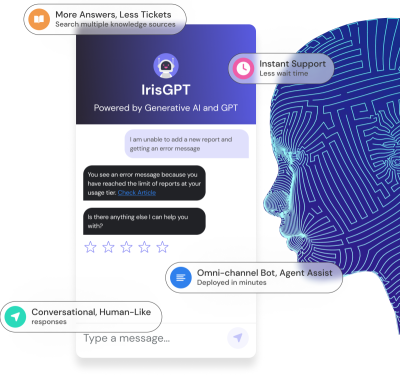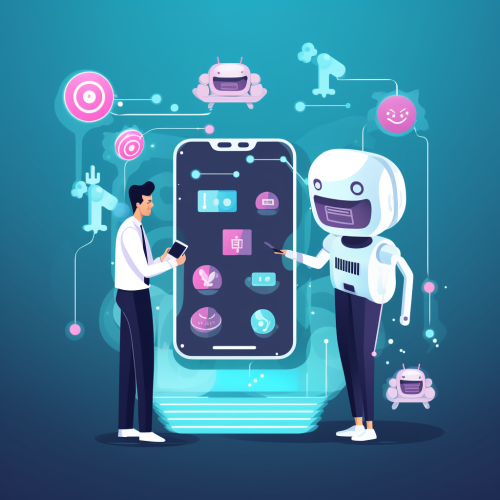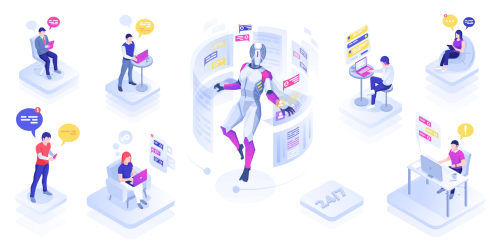What is Conversational AI? Explore Benefits & Uses in Customer Service
Conversational AI (CAI) refers to artificial intelligence technologies that can understand user queries and respond in a way that simulates natural conversations. It often utilizes underlying technologies like natural language processing (NLP), machine learning, and speech recognition to comprehend and generate human-like responses. Conversational AI technology is revolutionizing customer service, employing chatbots, virtual assistants, and other applications to provide efficient and effective support.
The advent of Generative AI technologies is furthering Conversational AI tools by having the ability to generate tailored and contextual responses to user queries.
Conversational AI tools, when used for customer service, can be found in chatbots, virtual assistants, agent assistance aids, messaging platforms, and other applications designed to engage in conversation with users. This article explains conversational AI chatbot concepts and emerging usage in customer service. It also discusses how organizations can start using Conversational AI solutions for their business and some of the best practices to maximize user benefits.
What is Conversational AI
Conversational AI refers to artificial intelligence (AI) that focuses on technology and systems capable of engaging in natural and human-like conversations with users. It leverages Natural Language Understanding, machine learning, deep learning, and other AI techniques to accurately understand and generate human language, enabling machines to interact with users through text or speech in a conversational manner. Understanding how conversational AI works involves delving into the roles of natural language processing (NLP) and machine learning (ML), which are pivotal in enabling these systems to process and learn from human language for more effective interactions. Key components and technologies that make up conversational AI chatbots include:
Natural Language Processing (NLP): NLP is the technology that enables machines to understand and interpret human language. It involves tasks like text parsing, sentiment analysis, and language understanding.
Speech Recognition: In applications that involve spoken language, speech recognition technology is used to convert spoken words into text, allowing the system to process and respond to voice commands.
Natural Language Generation (NLG): NLG is the process of generating human-like text or speech in response to user input. It’s crucial for providing coherent and contextually relevant answers. The advent of LLMs and generative AI has driven significant advancements in this area.
Machine Learning: Machine Learning algorithms are often employed to train conversational machine learning models using large datasets of human-generated conversations. These models learn to understand and generate human language.
Dialog Management: Dialog management systems help maintain a coherent and context-aware conversation. They decide what the system should say or do next based on the current conversation context.
Knowledge Base: Many CAI systems are integrated with a knowledge base, which contains information and data that the AI can reference to answer questions accurately.
How Conversational AI with Natural Language Understanding works in customer service
In customer service, Conversational AI solutions serve as a virtual assistant or chatbot that interacts with customers in real-time, addressing their inquiries, resolving issues, and providing assistance across various channels such as websites, mobile apps, and messaging platforms. The customer journey process typically involves the following steps:
User Input: The customer initiates a conversation by typing a message or speaking a query to the CAI interface.
Natural Language Understanding (NLU): The CAI system analyzes the user's input to extract the meaning, intent, and entities mentioned in the message.
Dialog Management: Based on the understanding of the user's intent and context, the system determines the appropriate response or action to take.
Natural Language Generation (NLG): The system generates a human-like response or output that addresses the user's query or request.
Response Delivery: The response is delivered to the user through the appropriate channel, such as text or speech.
Examples of Conversational AI technologies
There are various technologies and platforms driving the implementation of Conversational AI in customer service, each using AI technology and offering AI applications with unique capabilities and features. Some notable examples include:
Chatbots: Rule-based or AI-powered chatbots deployed on websites, messaging apps, or social media platforms to engage with customers, answer questions, and provide support.
Virtual Assistants: AI-driven virtual assistants, such as Amazon Alexa, Google Assistant, and Apple Siri, that offer voice-based interactions and perform tasks or provide information based on user requests.
Natural Language Processing (NLP) Libraries: Open-source NLP libraries like spaCy, NLTK, and Stanford NLP provide tools and algorithms for processing and understanding human language.
Dialogflow: Google's CAI platform that enables developers to build and deploy chatbots and virtual agents across multiple channels using NLU and NLG capabilities.
IBM Watson Assistant: IBM's AI-powered virtual assistant platform that helps businesses build and deploy chatbots and virtual agents for customer service and support applications.
Key Differentiators of Conversational AI for Customer Service
Several salient capabilities differentiate Conversational artificial intelligence, noteworthy ones include,
Natural Language Understanding (NLU): CAI tools are designed to comprehend and interpret human language. They can understand context, idiomatic expressions, and varied communication methods, making interactions more human-like.
Contextual Response with Intent Understanding: It can infer intent and maintain context throughout a conversation, allowing for more coherent interactions. CAI solutions can remember previous interactions, keep track of the information provided, which helps provide more accurate and relevant responses.
Adaptability and Learning: Conversational AI systems often employ Machine Learning algorithms that learn over time. They can adapt and improve over time based on the data they receive and their interactions, enhancing their ability to respond more accurately and effectively.
Personalization: Conversational AI systems can personalize interactions. They can remember user preferences, past interactions, and behaviors to tailor responses and recommendations.
Task Automation: CAI solutions can perform tasks on behalf of the user. This could range from setting reminders, making reservations, or handling customer service inquiries, thereby reducing the need for human intervention.
Continuous Availability: Chatbots and virtual assistants built on conversational AI are available 24/7, providing immediate responses and assistance to users without time constraints.
Scalability: These systems can handle a high volume of conversations simultaneously, making them suitable for scenarios where there's a need to interact with many users.
These differentiators collectively make conversational AI a powerful tool for businesses and customers, allowing for more natural, efficient, and effective human-computer interactions.
Examples of Conversational AI Chatbots in Customer Service
Customer service and support functions across a broad range of industries have greatly benefited from the evolution of Conversational AI technologies. The advent of Large Language Models that help with accurate and fast generative AI has furthered the efficacy of CAI for customer service and support. CAI manifests itself in the following popular ways in customer support and service,

Chatbots: Many companies utilize chatbots on their websites and mobile applications to immediately assist customers. For example, a bank might employ a chatbot to handle basic inquiries about account balances, transaction history, etc.
Intelligent Voice Agents: Voice assistants like Amazon's Alexa or Google Assistant are being integrated into customer service workflows. Some companies specialize in building Intelligent Voice Agents for customer service as a specialty - IrisAgent, Omilia, Nuance, Avaamo, Yellow.ai, and Kore.ai are a few that have gained traction.
Agent Assistance: Call center and customer service agents can access relevant content and responses to customer queries using CAI capabilities.
Post-Purchase Support: Conversational AI is employed to assist customers post-purchase. For example, it might help with order tracking return processes or provide additional information about the purchased product or service.
AI-Powered Knowledge Bases: Some customer service platforms use AI to develop and maintain extensive knowledge bases. These AI systems can retrieve relevant information to support customer queries, providing quick and accurate answers to various questions.
Reservation and Booking Systems: In the hospitality and travel industries, CAI manages bookings and reservations. These AI systems can assist customers in booking flights, hotels, or rental cars, providing information on availability pricing, and assisting in the reservation process.
Feedback and Surveys: CAI systems are employed to gather feedback and conduct surveys. These systems conversationally engage with customers to collect opinions, reviews, and insights about their experience, which can then be analyzed for improving services.
These applications of Conversational AI in customer service aim to streamline customer service interactions, provide quicker responses, improve overall customer experience, and reduce the workload on customer service teams for routine or repetitive tasks, allowing them to focus on more complex tasks or critical customer issues.
Benefits of Conversational AI for Customer Service
Conversational AI in customer service offers a wide array of benefits, transforming the way businesses interact with their customers. Key advantages include:
Self-Service: AI-driven systems empower customers to solve their issues independently by providing self-service options, with no need to wait on a call to speak to an agent.
24/7 Availability: CAI enables round-the-clock customer service, addressing queries and providing assistance anytime, even outside regular business hours. This ensures customers can get support whenever they need it.
Improved Response Time: AI-powered systems can provide instant responses to customer queries, reducing waiting times and enhancing the overall speed of service. This swift response contributes to better customer satisfaction.
Personalization: CAI systems can be designed to provide personalized interactions, using customer data and preferences to tailor responses and recommendations. This personal touch enhances the customer experience.
Cost-Efficiency: By automating routine tasks and inquiries, businesses can reduce the workload on customer service teams and improve customer service operations. This can lead to cost savings by optimizing human resources and allowing them to focus on more complex or high-value tasks.
Scalability and Accuracy: Conversational AI can handle a high volume of customer inquiries simultaneously without compromising the quality of service. It ensures consistent and standardized responses across all interactions.
Adaptability and Learning: These systems continuously learn and adapt based on customer interactions, allowing them to improve their performance over time. As they gather more data and feedback, they become more effective in addressing customer needs.
Data Collection and Analysis: Conversational AI can collect valuable data from customer interactions, enabling businesses to gather insights and analyze trends. This data can be used to understand customer needs, preferences, and behavior, which is crucial for refining products and services.
Implementing conversational AI in customer service can significantly improve and increase customer satisfaction, streamline operations, and increase loyalty and positive brand perception.
Getting Started with Conversational AI for Customer Service
Most organizations have some level of automation for support. Traditionally, it is an IVR, knowledge base, or self-service/FAQ section. To get started on Conversational AI, we recommend the following approach to build upon what may already be in place,
Define business goals and key use cases: Determine key business metrics, such as improvements in CSAT, call deflection rates, and first call resolution(FCR) rates. Start by identifying specific areas where Conversational AI can make a significant impact on these metrics.
Understand Your Audience: Understand your customer needs, preferences, and pain points. This insight will guide the design and functionality of your Conversational AI solution.
Design Conversation Flows: Design conversation flows by mapping out possible dialogues and user interactions. Prioritize user experience and design conversational flows that are intuitive and user-friendly.
Choose the Right Platform or Tools - Map the use cases to the capabilities that various platforms mentioned in the section above offer.
Compliance and Security: Pay attention to data privacy, security, and regulatory compliance to maintain trust and integrity with users' data.
Measure KPIs and improve: Test for accuracy, usability, and Natural Language Understanding Incorporate feedback loops to continuously improve the AI's performance based on user interactions and feedback.
Challenges and Considerations
Implementing Conversational AI in customer service presents various challenges and considerations that businesses must address to ensure successful deployment and utilization of conversational design. This section explores key challenges and considerations, including data privacy and security, managing customer expectations and trust, handling complex or sensitive inquiries, and balancing automation and conversational interfaces with human touch.
Ensuring data privacy and security:
One of the foremost concerns when implementing Conversational AI in customer service is ensuring the privacy and security of customer data. Conversational AI systems interact with users and collect sensitive information, such as personal details, payment information, and transaction history. Businesses must implement robust data privacy measures, including encryption, access controls, and data anonymization, to safeguard customer information from unauthorized access, breaches, or misuse. Compliance with data protection regulations, such as GDPR, CCPA, and HIPAA, is essential to avoid legal repercussions and maintain customer trust.
Managing customer expectations and trust
Building and maintaining customer trust is paramount in Conversational AI-driven customer service. Customers expect transparency, honesty, and reliability in their interactions with AI-powered systems. Businesses must set realistic expectations about the capabilities and limitations of Conversational AI, clearly communicating when interactions involve automated processes versus human assistance. Transparency in data usage, privacy policies, and security measures is crucial to building trust and fostering positive relationships with customers. Additionally, businesses must ensure that Conversational AI systems deliver accurate and relevant responses consistently to instill confidence and trust in their capabilities.
Handling complex or sensitive inquiries
Conversational AI systems may struggle to handle complex or sensitive inquiries that require nuanced understanding, empathy, or human judgment. Examples include inquiries related to legal matters, medical conditions, or emotional support. Businesses must identify such inquiries and implement mechanisms to escalate them to human agents promptly. Human agents can provide personalized advice, personalized assistance, empathy, and expertise in addressing complex or sensitive issues, ensuring a positive customer experience and mitigating the risk of misunderstandings or errors. Additionally, businesses should continuously train and update Conversational AI systems to improve their ability to handle a wider range of inquiries effectively.
Balancing automation with human touch
Achieving the right balance between automation and human touch is crucial in Conversational AI-driven customer service. While automation offers efficiency and scalability, human interaction provides empathy, understanding, and emotional support. Businesses must design Conversational AI experiences that seamlessly blend automation with human touch, ensuring that customers receive personalized, empathetic assistance when needed. Implementing mechanisms for human takeover or escalation enables Conversational AI systems to hand off inquiries to human agents seamlessly when automation reaches its limits. By striking the right balance between automation and human touch, businesses can deliver exceptional customer experiences and build lasting relationships with their customers.
Addressing these challenges and considerations is essential for businesses to maximize the benefits of Conversational AI in customer service while mitigating risks and ensuring a positive customer experience. By prioritizing data privacy and security, managing customer expectations and trust, handling complex queries and inquiries effectively, and balancing automation with human touch, businesses can harness the full potential of Conversational AI to drive customer satisfaction, loyalty, and business growth.
Best Practices of Conversational AI in Customer Service
Implementing Conversational AI in customer service requires adherence to best practices to ensure effectiveness, operational efficiency, and positive customer experiences. This section outlines key best practices for leveraging Conversational AI effectively in customer service operations.
Understand Customer Needs and Expectations: Before implementing Conversational AI, businesses must thoroughly understand their customers' needs, preferences, and pain points. Conducting market research, analyzing customer feedback, and studying support interactions can provide valuable insights into the types of inquiries customers have and the level of assistance they expect. By aligning Conversational AI capabilities with customer needs and expectations, businesses can deliver more relevant and valuable interactions.
Design for Natural and Engaging Interactions: Conversational AI experiences should be designed to mimic natural human conversations and engage users effectively. Use conversational language, avoid jargon or technical terms, and maintain a friendly and approachable tone. Incorporate visual elements such as emojis, gifs, and images to enhance engagement and convey emotions. Additionally, ensure that Conversational AI systems can handle interruptions, understand context, and maintain coherence throughout the interaction to provide a seamless user experience.
Provide Clear and Transparent Communication: Transparency is crucial in Conversational AI interactions to manage customer expectations and build trust. Clearly communicate when users are interacting with an AI system, and provide information about its capabilities and limitations. Inform users about data usage, privacy policies, and security measures to reassure them that their information is protected. Transparency fosters trust and confidence in Conversational AI systems, leading to more positive customer experiences.
Personalize Responses and Recommendations: Tailor Conversational AI responses and recommendations based on user preferences, behavior, and past interactions. Utilize customer data and insights to deliver personalized assistance, product recommendations, and solutions. Address users by their name, acknowledge their preferences, and anticipate their needs to create a personalized and relevant experience. Personalization enhances engagement, satisfaction, and loyalty, driving positive outcomes for both customers and businesses.
Empower Human-Agent Collaboration: While Conversational AI can handle many inquiries autonomously, there are instances where human intervention is necessary. Implement mechanisms for seamless collaboration between Conversational AI systems and human agents, enabling smooth handoffs and escalations when needed. Human agents can provide empathy, expertise, and complex problem-solving capabilities that complement the automation of Conversational AI. By combining the strengths of both humans and machines, businesses can deliver comprehensive and effective customer support experiences.
Continuously Monitor and Improve Performance: Monitoring and analyzing the performance of Conversational AI systems is essential for optimizing their effectiveness and identifying areas for improvement. Track key performance indicators (KPIs) such as response times, resolution rates, customer satisfaction scores, and conversation flow metrics. Gather feedback from customers and agents to identify pain points, areas of confusion, or opportunities for enhancement. Continuously iterate and refine Conversational AI models based on data-driven insights to ensure they remain relevant and effective over time.
By following these best practices, businesses can harness the power of Conversational AI to further customer engagement, deliver exceptional customer service experiences, enhance engagement, and drive positive business outcomes.
Conclusion
Conversational AI has gained significant traction in revolutionizing customer service. Organizations can streamline human interactions further, provide quicker responses, improve overall customer experience, and reduce the workload on human agents for routine or repetitive tasks, allowing them to focus on more complex or critical customer issues. Conversational AI, when done right with human-like interaction, can significantly improve CSAT, increase call deflection rates, improve agent performance, and increase First Call Resolution (FCR) rates.
Frequently Asked Questions
What is Conversational AI?
Conversational AI refers to artificial intelligence technologies that can understand and answer user queries and respond appropriately in a way that simulates natural human conversation.
Why should organizations care?
Conversational AI, when done right, can significantly improve CSAT, increase call deflection rates, improve agent performance, and increase first-call resolution (FCR) rates. With these improvements, businesses can drive better financial performance - saving operational costs while improving customer retention and the top line.
What platforms are available for Conversational AI?
Alexa from Amazon, Siri by Apple, Google Assist, and IBM Watson are popular platforms. In addition, there are platforms tailor-made for customer service and support. IrisAgent belongs to this category and we encourage you to sign up and set up a 30-minute discussion to get you started on your Conversational AI journey.




